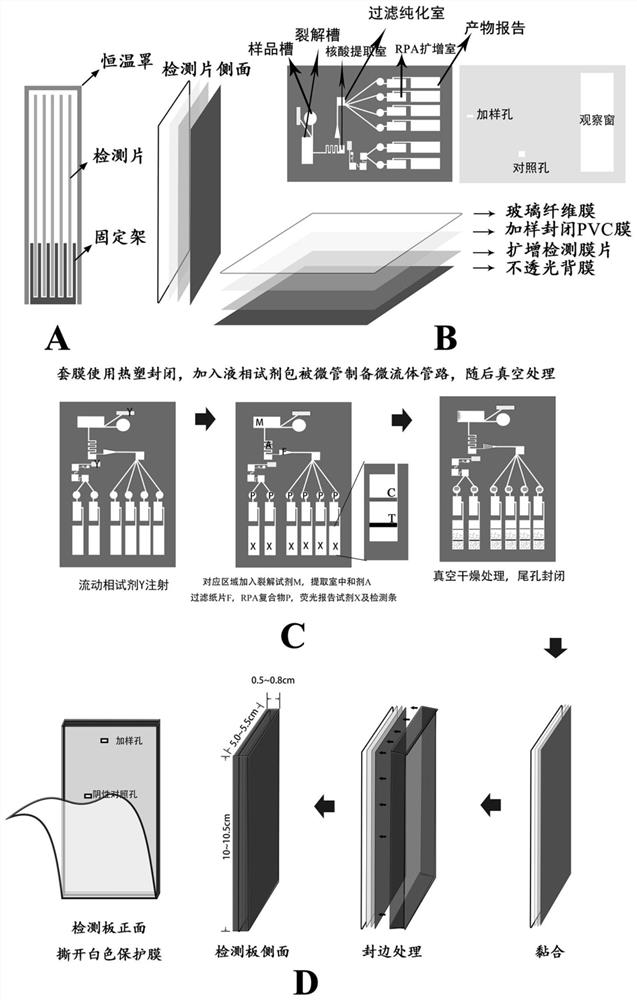RPA (recombinase polymerase amplification) reagent and device for detecting antibiotic resistance genes and detection method of RPA reagent and device
A technology of drug-resistant genes and antibiotics, applied in biochemical equipment and methods, DNA/RNA fragments, recombinant DNA technology, etc., can solve problems such as dependence, very high requirements for amplification reactions, and inability to adapt to different detection samples
- Summary
- Abstract
- Description
- Claims
- Application Information
AI Technical Summary
Problems solved by technology
Method used
Image
Examples
Embodiment 1
[0103] Example 1: Design of upstream and downstream primers and exo and nfo probes for detecting antibiotic resistance genes
[0104] A kind of RPA reagent for detecting antibiotic resistance gene, described antibiotic resistance gene is bla NDM 、bla KPC , mcr, tetLR, the reagents include: for detecting bla NDM Reagent A for drug resistance gene, for detecting bla KPC The reagent B for the drug resistance gene, the reagent C for detecting the mcr drug resistance gene; also includes: any one of the reagent D for detecting the tetL drug resistance gene and the reagent E for detecting the tetR drug resistance gene.
[0105] bla NDM The gene is an antibiotic resistance gene that produces metallo-beta-lactamase NDM, and the relevant primers and probes follow the sequence bla NDM-1 (KX999121.1), bla NDM-2 (KU510393.1), bla NDM-3 (JQ734687.1), bla NDM-4 (KP772213.1), bla NDM-5 (KP772211.1), bla NDM-6 (NG_049338.1), bla NDM-7 (JX262694.1) and other 22 conserved sequences of ...
Embodiment 2
[0185] Example 2: Verification of the Exo amplification system
[0186] Amplification reaction system and amplification conditions: the experimental groups RPND1 and RPND2 use the Exo-1 probe, and the experimental groups RPND3 and RPND4 use the Exo-2 probe. See Table 1 for details. The exo amplification reaction was monitored by a PCR instrument. The amplification program was as follows: set the isothermal mode, pre-amplify at 40°C for 1.0min, and amplify at 40°C for 31sec for a total of 40 cycles.
[0187] Amplification system sensitivity test: mark the plasmid DNA stock solution carrying the antibiotic resistance gene as P0, dilute it by 10 (P1), 100 (P2), 1000 (P3), 10000 (P4) and 100000 (P5) times respectively, and finally Prepare a serial dilution template 2×10 6 , 2×10 5 , 2×10 4 , 2×10 3 , 2×10 2 and 20 copies / mL, the RPA amplification experiment was carried out respectively, and this method analyzed the detection limit of the RPA amplification system to the templa...
Embodiment 3
[0196]Embodiment 3: Nfo amplification system verification
[0197] Amplification reaction system and amplification conditions: respectively adopt the primer pair and probe pair described in Example 1 containing bla NDM 、bla KPC , mcr, tetLR gene plasmid sequences for simulated amplification experiments. The amplification reaction was carried out with a PCR instrument, and the amplification program was set to an isothermal mode, with 40°C pre-amplification for 1.0 min, and 40°C amplification for 31 sec for a total of 40 cycles. Then pipette 5 μl of the amplification product and add it to 95 μl of PBST to prepare a reaction diluent, insert it into the lateral flow test strip containing the anti-FAM antibody of the commercial kit, and perform interpretation within 5 minutes.
[0198] Amplification system sensitivity test: mark the plasmid DNA stock solution carrying the antibiotic resistance gene as 1, and dilute 10, 100, 1000, 10 4 、10 5 、10 6 、10 7 、10 8 and 10 9 Times,...
PUM
 Login to View More
Login to View More Abstract
Description
Claims
Application Information
 Login to View More
Login to View More - R&D
- Intellectual Property
- Life Sciences
- Materials
- Tech Scout
- Unparalleled Data Quality
- Higher Quality Content
- 60% Fewer Hallucinations
Browse by: Latest US Patents, China's latest patents, Technical Efficacy Thesaurus, Application Domain, Technology Topic, Popular Technical Reports.
© 2025 PatSnap. All rights reserved.Legal|Privacy policy|Modern Slavery Act Transparency Statement|Sitemap|About US| Contact US: help@patsnap.com



